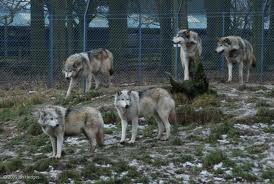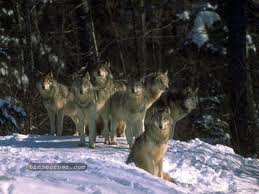Alpha Theory Dog Training
The Alpha "dominance" theories were based on short term studies in 1947 by Rudolph Shenkel of unrelated captive wolves in a Swiss zoo. Subsequent long term research on wolves in the wild has proved the conclusions of the original studies to be incorrect and misleading. 
Sixty five years later, however, these 'dominance/submissive' theories are still being used to justify and rationalize heavy handed and even harsh dog training. Popular TV shows promote the theory that in any group of dogs one or more is always competing for the 'alpha' postion. They will theoretically do so until the last one is standing, dripping in bloood, with breeding rights over all the females.
Force based methods in, say, traditional elephant training or horse 'breaking' have of course been used for thousands of years. Do they work? Absolutely! Are these methods nice or are they necessary? Absolutely not!
Cesar Millan, the most widely know of the trainer/TV entertainers, promotes this dominance 'pack' theory non-stop - it is the foundation on which his training and his fortune is built.
It is human nature to resist change and to scoff at innovation and to deride the innovators. Some people will, therefore, continue for evermore to use the same tried and true methods that have always worked for them, their fathers and their grandfathers and to profit from them.
Just because they produced results in the past does that mean that those methods are best or still the ones that we should be using today? Again, absolutely not! As with the advances made in medecine and in communications (e.g.key-hole surgery and smart phones) why not use newer, different, nicer, kinder and quicker training techniques to achieve the same goals?
In dog training - as with horse, elephants, birds and people - the older methods of training and behaviour modification have often been and unfortunately still are responsible for a great deal of confusion, unhappiness and abuse. That is the reason there is so much distate for the traditional techniques, re-packaged as being orginal and innovative and skilfully marketed, that some people continue to defend and promote and make their fortunes in so doing.

Used with permission of Lili Chin
www.doggiedrawings.net
facebook.com/doggie drawings
The article below provides an in-depth study of the fallacies of the Alpha Theory
"The Alpha Theory:based on a misguided premise"
© 2008Debra Millikan
Debra Millikan, Chief Trainer of Canine Behaviour School in Adelaide, was a traditional check chain and command-basedtrainer who was a successful obedience competitor and judge for many years. Her article below is reproduced in full with her kind permission in the hope that it helps to bring about further changes in the way some people still think and train their dogs.
"Writers who refer to dominance and alpha behaviour in dog training are basing their message on outdated and now disproved theory. Schenkel's studies (1947), upon which the alpha theory is based, were seriously flawed. In developing the dominance theory Schenkel was observing and passing judgment on unnatural behaviour.
The studies were of unrelated wolves that were forced to live unnaturally with each other in artificial, captive surroundings (a 1940's zoo environment) for many years. In this environment the unacquainted wolves did form dominance hierarchies with alpha, beta and omega animals and, in this situation, the dominance labels were appropriate. Basing observations on these living arrangements would be like "…trying to draw inferences about human family dynamics by studying humans in refugee camps (Mech 2000)". Unfortunately, based on Schenkel's work, and later championed in the dog training books written by the Monks of New Skete, the alpha theory has persisted and "…the prevailing view of a wolf pack is that of a group of individuals ever vying for dominance but held in check by the alpha pair" (Mech, 2000).
Professor David Mech from the Wildlife Department of Minnesota University and founder of the International Wolf Centre has spent more than 40 years studying natural wolf packs. He has shown that this prevailing view re dominance is false. In the wild, the typical wolf pack is "…a family with the adult parents guiding the activities of the group and sharing group leadership in a division-of-labor system" .The alpha male and female are simply the breeding pair within the pack (family) not the aggressive pair holding the others in check. Alpha wolves rarely use physical violence to communicate their position. Hierarchies within a pack are intended to reduce conflict, not cause it. Conflict does not promote harmony and harmony is needed for survival. 
In fact, it is the beta, or status-seeking wolves that are the most aggressive in the pack, as they constantly battle for higher position. So, if we apply ill-founded, captive wolf-related social dominance theory to our dog training and use physical methods we in fact communicate our position - one of a status seeker with little control. With regard to the concept of people acting like pack leaders, Coppinger and Coppinger (2001) say "Since dogs came from wolves, dogs should behave like wolves, think like wolves and respond to wolf like signals. But dogs can't think like wolves because they do not have wolf brains. We descended from apes but we don't behave like them and we don't think like they do. We are a much different animal than the apes in spite of our common genetic ancestry. The same is true of the dog and its ancestor".
Following his research into Dingo packs, Laurie Corbett (1985) presented a paper to the Ecology Society of Australia stating "Wild dingoes, therefore, can be tamed but not domesticated. Should humans determine and selectively breed certain standards and characteristics for dingoes, they will cease to be dingoes. A domesticated 'dingo' is not a dingo but just another breed of dog". By analogy, the same reasoning can be applied to dogs. Man has domesticated and changed many wolf traits in order to create hundreds of breeds to suit his purposes. We can no longer continue to treat our domesticated canine pets as if they are wolves – they simply are not.
Scientific research certainly demonstrates this (Wilkes 2006). He says "The odds that your dog is perfectly wolf-like are slim. This can lead to dramatic problems when you try to speak wolf language with your dog. While your Chow Chow may be missing the particular gene that allows him to understand why you are shaking him roughly by the scruff, he may still possess the gene that tells him to snap at your face". You flirt with danger when you try to apply wolf-like dominance struggles. You may well be able to control your large dog with your pure physical strength but what about other members of the family or guests in your home? If your dog is used to confrontational relationships with humans, can you be sure that that confrontation won't occur with a small child or an elderly relative?
Why dog trainers took up the dominance myth with such alacrity is a mystery. Steinker (2007b) believes it probably says more about the darker side of human nature than it does about any reliable scientific evidence.
So how then should we train our dogs? We could follow the ideas suggested by proponents of the dominance theory and continue subordinating both puppies and dogs by alpha rolling them, scruff shaking them, staring at them, holding them down whilst they struggle, suspending them above the floor, growling at them whilst they squirm helplessly out of fear and distress or by dangling them at arm's length until they stop trying to dominate us, until we are happy that they have been "dominated" or "subordinated". All these things we are at liberty to do, despite it showing a "…human lack of sensitivity to social signals that underlies much of our misunderstanding of what canine social behavior is about" (Spector, 2001). If we do, we are suffering from a phenomenon known as "belief persistence".
This phenomenon describes the maintaining of a strongly held belief even though evidence has totally discredited that belief (Davies, 1997). Sadly many dog trainers are still held by this phenomenon. Yes, training can be achieved using dominance and subordination; but at what cost to the human animal bond? "There is evidence that aversive stimulation (including positive punishment and negative reinforcement) damages any reinforcement history with your dog and may cause stress or aggression via counter-control" (Steinker, 2007a citing Sidman 2001).
O'Heare (2003) suggests dominance "…should not just be a theory void of empirical data (unsubstantiated), while it is bandied around by dog owners and so called professionals to justify the harsh treatment of pet dogs". Those who have continued to seek knowledge and follow the scientific research as it relates to pet dog training now know that there is another way (operant conditioning/positive reinforcement) and it has nothing to do with dominance. What proponents of positive reinforcement training are saying, based on scientific research and a great deal of common sense, is that building a bond of trust and respect with our dogs does not depend on domination or subordination. Training should be a symbiotic relationship between humans and dogs.
Modern training now focuses on the control of valuable resources and positive reinforcement training methods, rather than physical violence. But does it work? From Sydney University comes this statement "Analysis of the efficacy and psychological impact on training techniques has brought about welfare improvements primarily by enabling trainers to select regimes that work, inflict no harm, mentally engage the animal and consequently put an end to the aggression-punishment-aggression cycle that may stem from punishment-based training. Improved training also strengthens the human/canine bond and therefore has a secondary effect by reducing relinquishment to pounds." (Curl 2004).
A really important aspect here is the mental engagement of the dog. A dog that is afraid of consequences will offer no behaviour of his own. A dog that is positively reinforced for good things will volunteer behaviour to be rewarded. The mental engagement of the dog is paramount to learning. We all know that if we are disinterested, scared or threatened, our ability to learn is reduced.
Hiby's work for the Universities Federation for Animal Welfare (2004) surveyed 600 dog owners in the UK who trained using either aversive methods, reward based methods or a combination of both and included such behaviours as house training, chewing, stealing objects, sitting, coming, heeling and leave it. She concluded "…although the most effective technique varied according to the specific training task, for NONE of the tasks was a punishment based method most effective". She states "Furthermore, dogs trained using only reward based methods were reported significantly more obedient than those trained by other means, identifying reward based methods to be the most effective overall training method."
O'Heare best sums up the situation when he states "By setting up a paradigm or model in the owner's mind that someone should be the leader, we imply that someone else should not be, and it can simply sow the seeds of an adversarial relationship that can cause damage to the relationship between owner and dog…My preference is to simply focus on behavior, avoiding any talk of dominance…They are not necessary and they can lead to misunderstandings. (Owners) should be advised to take every opportunity they can to train the dog, using the principles of positive reinforcement for desirable behavior and preventing reinforcement of unwanted behavior. People who impose a power-struggle view on their relationship will see exactly what they impose; this is a no-win scenario. Simply train the dog" (O'Heare, 2007)
References
- Coppinger R and Coppinger L, 2001. Dogs. A New Understanding of Canine Origin, Behavior and Evolution. University of Chicago Press, Chicago, USA.
- Corbett L, 1985. Morphological comparisons of Australian and Thai dingoes: A Reappraisal of Dingo Status, Distribution and Ancestry. Proceedings of the Ecology Society of Australia 13:277-291.
- Curl, P. 2004. An Evaluation of Dog Training Techniques: An Assessment of Efficacy and Welfare. Sydney University Animal Welfare Science Essay. Retrieved on 4 April, 2008 from http://vein.library.usyd.edu.au/links/Essays/2004/curl.html
- Davies, MF. 1997 Belief persistence after evidential discrediting: The impact of generated versus provided explanations on the likelihood of discredited outcomes. Journal Experimental Social Psychology 18:561-578.
- Hiby EF, Rooney NJ, Bradshaw JWS. 2004. Dog Training Methods: Their Use, Effectiveness and Interaction with Behaviour and Welfare. Animal Welfare 2004, 13:63-69.
- Mech L David. 1999. Alpha status, dominance and division of labor in wolf packs. Canadian Journal of Zoology 77:1196-1203. Retrieved on 17 March 2008 from http://www.mnforsustain.org/wolf_mech_dominance_alpha_status.htm
- O'Heare J. 2003. Dominance Theory and Dogs. DogPsych Publishing, Ottawa, Canada
- O'Heare J. 2007. Aggressive Behavior in Dogs. A Comprehensive Technical Manual for Professionals. DogPsych Publishing, Ottawa, Canada
- Schenkel R 1947. Expression Studies on Wolves – Captivity Observations. Behavior 1:81-129. Retrieved on 17 March 2008 from www.davemech.org/schenkel/index.html
- Sidman, M. 2001. Coercion and It's Fallout. Cambridge Center for Behavioral Studies, Cambridge
- Spector M. 2001. Moving Beyond the Dominance Myth: Toward an Understanding of Training as Partnership. Retrieved on 3 April 2008 from http://www.4pawsu.com/MOVING%20BEYOND%20THE%20DOMINANCE%20MYTH.pdf
- Steinker, A. 2007a Terminology Think Tank: Social Dominance Theory as it Relates to Dogs Journal of Veterinary Behavior (2007) 2, 137-140
- Steinker, A. 2007b Social-Psychological Dynamics in Dog Training: The Power of Authority and Social Role Designation and its Possible Effects on Dog Training. Journal of Applied Companion Animal Behavior, 1(1) 7-14.
- Wilkes G. Alpha Schmalpha Retrieved on 2 April 2008 from http://apromisepluskennels.com/21401/33201.html
Recommended Reading
- American Veterinary Society of Animal Behavior (2007). Position Statement: Guidelines on the Use of Punishment for Dealing with Behavior Problems in Animals. Retrieved on 3 April 2008 from http://www.avsabonline.org/avsabonline/index.php?option=com_contentandtask=viewandid=80andItemid=215
- Clicker Training for Obedience. Spector M 1999. Sunshine Books Inc, USA.
- Coercion and It's Fallout. Sidman, M. 2001. Cambridge Center for Behavioral Studies, Cambridge
- Dogs. A New Understanding of Canine Origin, Behavior and Evolution. Coppinger and Coppinger 2001. University of Chicago Press, Chicago, USA
- Dominance Theory and Dogs. O'Heare J 2003. DogPsych Publishing, Ottawa, Canada
- Don't Shoot the Dog (Revised Edition). Karen Pryor. 1999. Bantam Books, New York, USA
- The Complete Idiot's Guide to Positive Dog Training (second Edition). Pamela Dennison. Penguin Group, New York, USA
- The Culture Clash (2nd Edition). Jean Donaldson. 2005. James and Kenneth Publishers, California, USA
- What's Wrong with Dominance Theory and Aversives? Two Common Problems in Working with Dogs. James O'Heare 2008. Retrieved on 3 April 2008 from http://www.iiacab.com/whatswrongwithdominancetheory.pdf"


